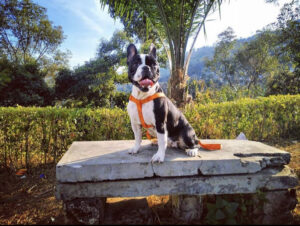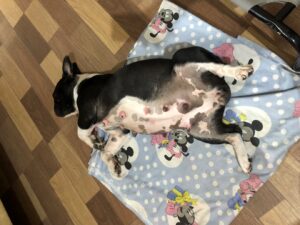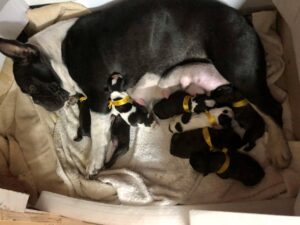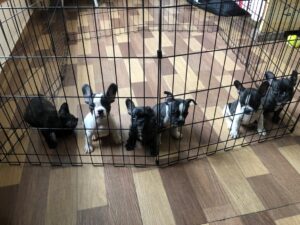NEONATAL CARE OF FRENCH BULLDOG PUPPIES-A Personal Account
Nirmali Sarma, PhD Scholar,
Department of Veterinary Surgery and Radiology,
College of Veterinary Science, Assam Agricultural University,
Khanapara, Guwahati-781022, Assam.
The bat ears, large bright eyes, stubby tail, compact and muscular body, playful nature and remarkably docile demeanour; some of the innumerable qualities that make the French bulldogs an excellent companion animal. Due to their smaller body size, these dogs make good travel companions as well. Additionally, their intelligence and quick adaptability ensure that they are safe to be let about around infants and old members of the family as well. It is no wonder that they have taken the world by storm and now most dog lovers around the globe want a ‘Frenchie’ of their own. To these statements, I can attest myself for I have a 4 years old female French bulldog – one of the most brilliant dogs that my family has ever had the privilege to own. She has incorporated herself into the typical Indian family hierarchy quite efficiently and has her own distinctive place as the ‘granddaughter’ of my parents.
However, during these past four years, one major concern surfaced itself time and again to my veterinarian parents: Pyometra. Throughout his clinical experience of beyond 30 years as a veterinary surgeon, my father has observed numerous cases of ‘unmated’ bitches ending up with a serious and life-threatening condition called Pyometra.
Pyometra is defined as an intrauterine accumulation of pus accompanied by a persistent corpus luteum and failure of oestrus. Apparent failure of the endometrial luteolytic factor or endogenous prostaglandin to cause luteolysis makes bitches appear and behave as though they were gestating. Risk factors for pyometra include increasing age, nulliparity, breed, and exogenous oestrogen or progesterone administration.
Spaying (Ovariohysterectomy) completely and promptly removes the infection, prevents uterine rupture and peritonitis, and prevents recurrence, in most cases. Spayed animals do very rarely develop pyometra in the uterine stump. Even so, ovariohysterectomy is currently considered the most effective and safest treatment.
It is thus, a very important disease to be aware of for any dog or cat owner because of the sudden nature of the disease and the deadly consequences if left untreated. While it is observed that this condition may occur in any dog regardless of age and mating history, it is more common in bitches that have not whelped even once throughout their life (nulliparous).
Therefore, after a proper discussion and consultation with scientific literature, we decided to allow our French bulldog to mate with a healthy adult male of the same breed.
Little did we know what was in store for us in the next few months to come. Our dog conceived successfully and started showing some symptoms of gestation such as gradual enlargement of abdomen, quick exhaustion, reluctance to run or play, enlargement of mammary glands, etc. However, she lost her appetite abruptly and refused to eat her meals about two weeks into her pregnancy. As her abdomen rapidly grew in size, her appetite reduced alarmingly. To manage the issue, she was given appetite inducers, liver supplements and shifting of meal ingredients from fish, to egg, to chicken, to pork alternatively, in an attempt to spark her interest. She ate almost nothing. There was gradual loss of condition as her abdomen distended significantly. At merely 30 days of gestation, her general appearance was of a bitch at full term. A general abdominal ultrasound was conducted on the 40th day of gestation and roughly 7 puppies were observed even though the number could be greater since unlike X-ray, the number of foetuses cannot accurately be determined using ultrasonography and we were unwilling to conduct radiography due to radiation hazard.
As she entered the end of her term, Paris was visibly distressed due to the significant enlargement of her uterus and its extension cranially rendering her unable to rest in dorso-ventral or lateral recumbency due to the increased pressure on her diaphragm restricting sufficient inflation of her lungs during respiration. She instead preferred to sit close to walls and furniture and lean for support, thus keeping her thorax elevated than her abdomen to reduce pressure on her diaphragm while breathing.
There were a couple of concerns we were ailed with. Since French bulldogs are known to have a narrow pelvic girdle and foetal head size is typically large, normal parturition could lead to lodgement of the head of the foetus in her birth canal leading to dystocia. This is why being a veterinary surgeon; I had made all preparations for a caesarean section.
Additionally, on an average, French bulldogs have no more than 5 puppies per litter but in the case of my dog Paris, her litter size appeared considerably larger upon ultrasonography, which could be correlated with her abnormally distended abdomen.
On the 58th day of gestation, she displayed vivid signs of labour such as nesting, restlessness, panting and straining. We were alarmed due to her pre-term parturition since there were still 3-5 days of pregnancy remaining. At 6:30 pm in the winter evening she delivered her first puppy via normal parturition without incident and continued to deliver 8 more over the next 7 hours and delivered a total of 9 puppies of which one was still-born. It was severely cold and raining outside.
She displayed admirable maternal instinct and licked away the foetal membranes from all the puppies enabling them to breathe and stimulated them by licking their faces and bodies until the pups let out their first cries.
The umbilical cords were ligated firmly using Polyglactin 910 (size 2/0) suture at a distance of 1.5 inches from the umbilicus, then snipped distal to the ligation with a pair of sterile scissors. The puppies were cleaned and stimulated further by rubbing gently with sterile absorbant cotton. Unlike most other breeds of dogs, Paris readily allowed us to handle and care for her pups, trusting us completely to keep them safe.
Considering the chilly weather, the pups were provided with sufficient baby blankets and an electric heater placed 1.5 metres away to stay warm without overheating. On the first two nights, the puppies were allowed to remain with the mother however; we lost another pup as a result of crushing injury inflicted due to her lack of experience.
It was then decided to undertake human intervention so as to ensure the safety of the remaining 7 puppies and avoid such accidents in the future. On the 4th night however, the mother managed to get into the basket housing her puppies, reached in with her mouth and carried out one puppy then took her to her bed. The puppy was licked thoroughly by the mother and was only discovered approximately 4 hours after the incident. By then the puppy was hypothermic and dehydrated. Due to severe dehydration and subsequent hypoglycaemia, she was very weak, unable to suckle milk and twitched in frequent intervals. Intensive care was initiated immediately and the puppy was separated from the rest, kept constantly warm at 39 degrees Celsius, fed artificial milk in intervals of 1 hour. However, not much improvement could be observed. 33 hours later, I decided to dip my small finger in honey and allow the puppy to taste it. After repeating the procedure thrice, she visibly regained strength and began suckling on the finger showing intent. I continued to feed her the milk replacer at 1 hour intervals and 0.5-1.0 ml of honey twice daily. This was continued until she regained vigour and could suckle her mother’s milk without assistance and was then released back to her litter.
The puppies were closely monitored and allowed access to the mother only during the nursing times maintained for the first 3 weeks at 3 hour intervals where the puppies were given mother’s milk and supplemented with ‘Babydog Milk’ by Royal Canin. Cotton balls dipped in warm water were used to gently rub the anal orifice and penis/vulva to stimulate defecation and urination, respectively. This is an essential step since most puppies at neonatal stage are unable to void faeces and urine independently and require stimulation from the mother by licking or artificially using soaked cotton balls. In the case of Paris, she would tend to lick using excessive pressure perhaps due to her overwhelming maternal instinct, which is why we had to deter her from doing so and took charge of the issue ourselves.
From the 4th week, feeding was repeated at 4 hour intervals and subsequently increased to 6 hours at the age of 6 weeks.
The pups were shifted from milk to mini starter ration by Royal Canin at 4 weeks age, to be continued until 16 weeks.
They are currently 12 weeks old and in the past couple of months, I have put my theoretical knowledge on neonatal care of puppies into practical application.
General status of health could be assessed by observing faecal consistency and frequency. Neonates void yellow or brown semi-solid faeces with a seedy appearance at intervals of 2 to 3 hours. Faeces solidify gradually and take the form of small boli in healthy puppies without gastrointestinal ailments and having sufficient hydration.
Anaemia was assessed by colour and dryness of the oral mucous membranes, dehydration could be assessed by pulling the skin on the back using thumb and index finger as well as the colour of urine. Healthy puppies void clear, colourless to slightly yellow urine, and dehydrated puppies have dark yellow urine voided in scanty quantities.
The first two weeks are very crucial since the puppies were prone to hypothermia and hypoglycaemia if optimal room temperature and feeding schedule is not carefully maintained. Thermoregulatory mechanism is not active in puppies until 3 weeks of age rendering them prone to rapid decline in body temperature, which needs to be controlled using external heating system, maternal body heat and consumption of mother’s milk.
The puppies’ eyes opened at 9 days age. Methylcellulose eye drops were instilled at 6 hour intervals for one week to prevent corneal desiccation.
The mother resumed feed consumption the morning after her delivery. Her diet was supplemented with multi-mineral and multivitamin syrup (Multistar Pet) and calcium chew tablets (Drools) to help her regain optimal health as well as to sustain the high nutritional requirements during lactation.
All puppies were vaccinated with Puppy-DP (Distemper and Parvovirus) at 30 days age considering the facts that Paris missed her vaccination during her pregnancy and a Parvoviral infection was on-going as an epidemic in the city. Additionally, the puppies were kept under complete isolation and I had to place myself under home-isolation since I would encounter multiple Parvo and Distemper cases at my workplace. No visitors were allowed until 60 days age when they were administered with vaccination against DHPPiL (Canine Distemper, Infectious Canine Hepatitis, Parvovirus, Parainfluenza and Leptospirosis).
It is with great pride that I can say that all seven puppies have shown remarkable growth and development, are healthy, happy and playful.
FIGURES:
FIG.1. A healthy female French Bulldog (Paris), 4 Year age.
FIG.2. A photograph of Paris at 30 days of gestation, with distended abdomen and mildly enlarged mammary glands.
FIG.3. A photograph of Paris resting with her fully fed puppies after nursing.
FIG.4. Six French bulldog puppies of 60 days age, sitting attentively for a photograph.
https://www.pashudhanpraharee.com/french-bulldog-breed-of-dog/
https://frenchbullevard.com/french-bulldog-care/how-to-take-care-of-newborn-french-bulldog-puppies/






